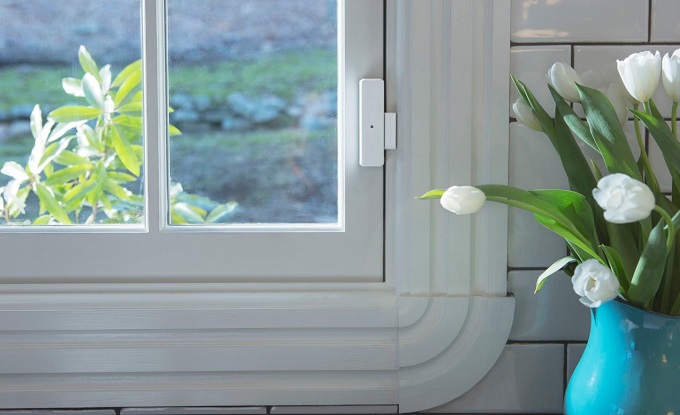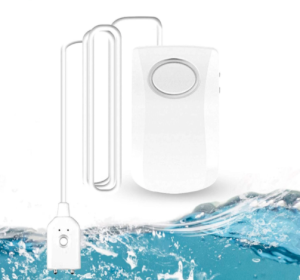
Today’s advanced home security systems take advantage of a wide variety of sensors to detect a range of potential security threats from intrusion to fires. In this blog, we’ll consider what sensors are and how they work. We’ll also review some of the more common types of security sensors and how each contributes to the overall safety of your home.
FIRST RESPONDERS: HOME SECURITY SENSORS
A home security sensor is any device designed to detect changes in the environment in or around your home that could indicate a security threat.
Sensors are designed to detect changes in air quality that could indicate smoke or a gas leak, changes in temperature that could be the result of fire, or the presence of moisture in areas that could suggest flooding.
More sophisticated sensors can detect a door opening or a window being broken when an electrical circuit is broken. Such sensors can detect motion in a field of vision, while smart systems can be designed to pick up movement in a security camera feed.
When any of these changes are detected, sensors can trigger alarms and send an alert to homeowners, monitoring centers, and even first responders to the situation.
Highly integrated home security systems continuously monitor inputs from a wide range of sensors, with centralized systems identifying which sensors are being triggered and where to pinpoint potential threats.
These systems can alert responders directly with detailed information and send text messages to property owners. They can even take steps to mitigate the situation, such as activating fire suppression systems in the affected areas or shutting off water when a leak is detected.
TYPES OF SECURITY SENSORS
Now let’s take a look at what types of sensors are used in home security alarms. The most common types of home security sensors include:
- Door and window sensors
- Glass break detectors
- Motion detectors
- Heat and smoke detectors
- Carbon monoxide detectors
- Water bugs (moisture detectors)
Let’s consider the role each of these sensor types plays in improving the safety and security of your home.
1. DOOR AND WINDOW SENSORS
Window and door sensors are the foundation of any home security system. These comprise two pieces: a magnet that fits on the door or window itself and a circuit carrying part that fits on the door or window frame. These are positioned right next to each other. When the pieces are separated, the loss of magnetic field breaks the circuit in order to trigger the alarm.
These compact sensors can also be used to monitor enclosures such as safes and cabinets within the home, including:
- Gun Safes
- Medicine Cabinets
- Liquor Cabinets
- Tool Cabinets
2. GLASS BREAK SENSORS
While window sensors would detect someone opening an unlocked window, but do nothing if the window itself is broken. Glass break detectors are designed to listen for the impact or noise pitch of glass breaking.
These cost-effective sensors also cover all windows within line of sight extending roughly 25 feet, offering protection to multiple potential entry points.

3. MOTION DETECTORS
Motion sensors use infrared energy to detect movement within a monitored space. They measure about 45 degrees and are usually placed in the corner of an interior wall.
When someone walks into a room, the sensor immediately identifies their temperature, turning on lights or triggering an alarm. Motion sensors can also be set for different distances and sensitivities.
An experienced security equipment provider like Security Alarm will be able to customize motion detection to your home. We’re also able to adjust and program motion “pet immune” detectors that will not be triggered by your pets or wildlife moving in your yard.
4. FIRE & SMOKE DETECTORS
The most important types of sensors are the ones that protect against fire. Heat and smoke detectors monitor temperature and air quality continuously to detect fire and smoke. These monitors must be located strategically throughout your home to protect you and your family.
Heat detectors work simply by picking up sharp changes in temperature in the area surrounding them. Smoke detectors work either by picking up changes in how quickly particles in the air are ionized or by monitoring disruption to a light beam passing through a light chamber.
5. CARBON MONOXIDE SENSORS
Carbon monoxide sensors detect CO, a deadly odorless gas. Carbon monoxide is difficult to detect and sensors must use a range of sophisticated technologies to pick it up. These range from color-changing gels to highly sensitive electrical circuits that conduct less power when CO is present.
Carbon monoxide sensors are a life-saving technology in the event of a fire, or when a motor or stove is left on in an enclosed space.

6. WATER BUGS (MOISTURE DETECTORS)
Flooding is a common and underappreciated threat to your home. Flooding from extreme rainfall, a broken pipe, or a failed water heater can cause thousands of dollars of damage before you have a chance to respond.
Water bugs are designed to detect high levels of moisture in areas that should be dry. They are commonly installed in kitchens, bathrooms, laundry rooms, basements, and other areas that may be prone to flooding. They immediately alert you or your monitoring service, while those connected to integrated home security systems can even shut off the water supply.
PEACE OF MIND: GETTING A HOME SECURITY SYSTEM
Your home is no place to compromise when it comes to safety. At Security Alarm, we offer reliable, durable security solutions that keep your family safe and make sure you and first responders are notified in case of an emergency.
Whether you are at home, asleep, or out of town, let Security Alarm take the lead in helping you keep what is most precious to you safe and secure. Click below to learn more or get a free quote!
